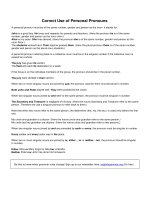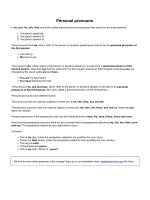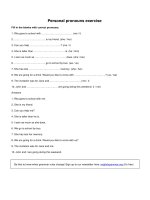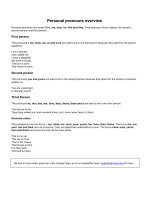English personal pronouns
Bạn đang xem bản rút gọn của tài liệu. Xem và tải ngay bản đầy đủ của tài liệu tại đây (11.93 KB, 1 trang )
Personal pronouns
I, we, you, he, she, they
and
it
are called personal pronouns because they stand for the three persons:
1. the person speaking
2. the person spoken to
3. the person spoken of
The pronouns
I
and
we,
which refer to the person or persons speaking are said to be the
personal pronouns of
the first person.
I
am fed up.
We
have to go.
The pronoun
you
, which refers to the person or persons spoken to, is said to be a
personal pronoun of the
second person
. Note that
you
has the same form for the singular and plural. Both singular and plural
you
are
followed by the plural verbs
are
and
have.
You are
my best friend.
You have
betrayed my trust.
The pronouns
he, she and they
, which refer to the person or persons spoken of are said to be
personal
pronouns of the third person
.
It
is also called a personal pronoun of the third person.
Personal pronouns have different forms:
The pronouns that are used as subjects of verbs are:
I, he, she, they, you and we.
The personal pronouns that are used as objects of verbs are:
me, him, her, them, you and us
. Note that
you
does not change.
Personal pronouns in the possessive case has the following forms:
mine, his, hers, theirs, yours and ours.
Note that the possessive pronouns shall not be confused with the possessive adjectives
my, his, her, their, your
and our.
The possessive adjectives are used before nouns.
Compare:
This is
my
dog. (Here the possessive adjective my qualifies the noun dog.)
Those are
their
books. (Here the possessive adjective their qualifies the noun books.)
This dog is
mine.
Those books are
theirs.
This is
my
coat. Where is
yours?
Be first to know when grammar rules change! Sign up to our newsletter here: englishgrammar.org (It's free)
Powered by TCPDF (www.tcpdf.org)









